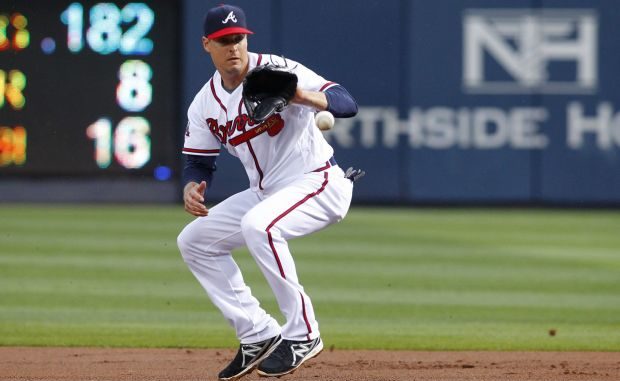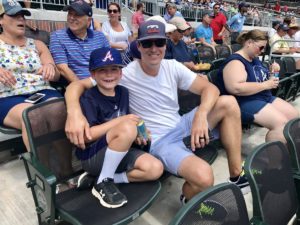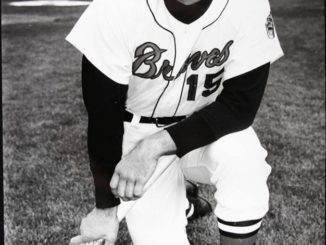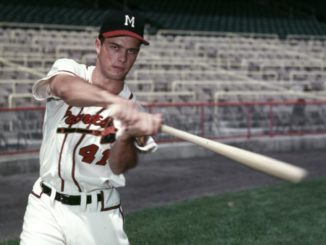
See also: Best Brave By Uniform Number Index
We can not truly define what a “man-crush” is because Merriam-Webster does not yet include it in its vast dictionary. But just know that I had one for Kelly Johnson. Over three stops with the Atlanta Braves, his sweet left-handed swing led to 55 homers with the Braves and a .763 OPS. He played all over the field for the franchise, a truly selfless act for such a star. And for his efforts, as Herculean as they were, Johnson is Outfield Fly Rule’s Best Brave to wear #2.
Born and raised in Austin, Texas, Johnson put up incredible numbers for Westwood High School. He’d go on to hit 152 more major league homers than anyone else from Westwood. You might argue that the only other player from Westwood to play in the majors was Brent Clevlen and you might be right, but that does not change just how much more impressive Johnson was than anyone else from that school. You’re absolutely right that Kelly Johnson broke the mold.
As the 2000 draft loomed, the Braves nervously waited for Johnson to come available with their #29th overall pick. And then they drafted Adam Wainwright.
No worries as they also had the 30th overall pick. Which they used on Scott Thorman.
Seven teams could have stolen Johnson from the Braves, including the Mets which would have saved a lot of grief in all honesty. But pick-after-pick went by until the #38th overall selection. The Braves finally made up for past mistakes by selecting Johnson, who they later got at a bargain price signing bonus of $790,000. The Atlanta Braves had their star of the future.
Triumphant March Through the Minor Leagues
For the rest of the summer, Johnson went down to Florida, homering four times in 53 games with a .349 OBP for the GCL Braves. But it was in 2001 with Macon that Johnson became a prospect to watch… and a man-crush to end all man-crushes began. In a shade under 500 plate appearances, Johnson hit .289 with a .404 OBP and a .513 SLG. Quick math – that’s a .918 OPS. He added 22 doubles, 23 homers, and 25 steals. The Braves realized that they could do no better than Johnson and 2001 would be the second-to-last season for the Braves in Macon. The franchise had to move, for no one could ever live up to the pressure to be the next Kelly Johnson in that city. It was entirely too much.
The hellish winds in Myrtle Beach did Johnson no favors in 2002 and a year later, with Greenville, his “struggles” continued. Sure, he was better than 95.69% of the minor leagues, but he was not posting the kind of numbers he had in 2001. Yet, the Braves knew what kind of talent they had. They sent him to Arizona to play in the prestigious Arizona Fall League. Using that as a jumpstart, Johnson returned to Greenville in 2004 and slashed .282/.350/.468. He kept hitting with Richmond the following year, bashing the International League over the first two months before the Braves realized they could no longer keep this superstar down and promoted him.
Conquering the Majors
How excited were the Braves? They looked Chipper Jones in the eyes and told the future Hall of Famer that he was no longer going to hit third. That was Johnson’s spot. Andruw Jones? You’re hitting sixth. We need to make sure we put Johnson in a prime hitting spot. They even moved him to left field because when you have a Kelly Johnson, you find a spot for him to play. He walked in his debut and scored a run, quickly proving his value. He would walk in each of his first four starts as if he was some true veteran. Yes, he didn’t have a hit until his 16th at-bat and 19th plate appearance, but why are you focusing on the negative?
After a 1-for-30 start that included a 2/1 BB-to-K rate, Johnson found his footing and slashed .340/.448/.598 over his next 25 games. Overall, you might look at his .731 OPS and think it was a disappointment. I choose to look at the positive side and Johnson brought a lot of positives. Yet, for reasons that still make no sense to me, Johnson was reduced to a pinch hitter in the NLDS as Brian Jordan and Ryan Langerhans started ahead of him. I guess Bobby Cox hated winning.
Johnson would miss the 2006 season with Tommy John surgery. The Braves had their first losing season since 1990. That makes complete sense when you lose an irreplaceable star like Johnson.
After Marcus Giles — still suffering from running into Andruw Jones — played his way out of Atlanta, the Braves had a new idea of how to unleash Johnson. He was moved to second base for the 2007 season. Selflessly, I may add. Furthermore, he retired his #27 in favor of the #2. He then played out-of-his-mind baseball as the new leadoff hitter for the Braves. In 2007, Johnson hit .276/.375/.457 with 26 doubles, ten triples, and 16 homers. He became one of history’s greatest All-Star snubs, sitting home for the break despite a .852 OPS over his first 83 games. Only Alex Rodriguez, Chipper Jones, and 46 other players had a better fWAR than Johnson in 2007. Frankly, the fact he didn’t receive one MVP vote is a travesty that no one ever talks about!
Johnson’s follow-up campaign in 2008 was good. He hit 39 doubles, stole eleven bases, and hit .287. Sure, his walk rate went down. And his isolated slugging. And his WAR. But consider how distraught Johnson had to be after receiving little fanfare for his successful 2007. He’s a person. A human being. Who are you to doubt Kelly Johnson? He’s a serious professional and he has emotions and feelings and a deepness to him of the likes you’ve never seen in your whole entire life.
The First Betrayal
In 2009, the Braves had a new fling. Some guy named Martin Prado. Oh, sure, he bested Johnson in every category – including strikeouts and grounding into double plays. But the Braves still believed in Prado over Johnson, non-tendering the superstud second baseman after the year to open up even more playing time for Prado. Yet again, just another travesty.
Johnson’s time with the #2 uniform with the Braves ended with that non-tender. He hit .269/.349/.786 in just over 1,500 plate appearances with 85 doubles, 19 triples, and 36 homers to go with 27 steals. He ranked 14th for those three years among second basemen in fWAR, which I think we can all agree is reason enough to doubt the validity of the entire statistic.
Of course, Johnson’s career wouldn’t end with that non-tender. He’d explode with a career-best .865 OPS in 2010 with the Diamondbacks, showing just how wrong the Braves were to give him up for nothing. He’d remain a starter for the next two seasons, spending half of his time with the Toronto Blue Jays after a 2011 trade from Arizona. In 2013, he continued his side-quest to play for the entire AL East by joining the Rays. Then, like a champ, he finished off that sidequest in quick fashion in 2014 by playing for the Yankees, Red Sox, and Orioles – all in one year! What an accomplishment!
The Return, the Second Betrayal, and the Third Betrayal

In 2015, Johnson played his way back onto the team he once was a 2005 Baby Brave with as he re-joined Atlanta. Possibly believing he needed a fresh start, Johnson left the #2 in the past and opted for #24. Like the crafty vet he truly is, he played five different positions for the Braves and hit .275/.321/.451 – looking renewed as a leader of a downtrodden Braves team. For his selfless act, he was traded to the Mets to finish the year. What a middle finger that was. Giving the Braves one more chance, Johnson returned in 2016, and again, the team cast him aside, exiling him to Flushing with little care. Yet, Johnson still holds no grudges and cheers on the Braves, often returning to do team functions. Because that’s the kind of guy Kelly Johnson is.
A true genuine hero.
Thank you for your service, Kelly.
Honorable Mention
- Rafael Belliard wore the #2 from 1991 to 1998 for the Braves. While his bat was never much to write home about, Belliard was a fan favorite who was smooth with the glove. His biggest moment at the plate, aside from his second major league homer in 1997, may have been his suicide squeeze in the bottom of the 7th of Game One of the 1995 World Series. The bunt scored David Justice, giving the Braves a 3-1 edge. They’d go on to win 3-2.
-
Al Dark would become far more well-known for his time with the New York Giants, where he was a three-time All-Star, but he started his career with the Boston Braves in 1946 for a cup of coffee. In 1948, he donned the #2 and hit .322, becoming the franchise’s first Rookie of the Year winner. The award was given for the first time the previous year to Jackie Robinson. 1948 was also the last year only one Rookie of the Year was chosen as both leagues would get to name one the following year. Dark’s second full season in Boston was not as glamorous with the bat and he was dealt in a six-player deal after the season.
Who Is the Best Ever To Wear #2?
Okay, I’m going to actually not sit here and pretend Kelly Johnson is in the discussion. I have a hefty man crush, but at the end of the day, I can be objective.
A lot of great players have worn the #2. The list includes Jimmie Foxx, Craig Nettles, Roberto Alomar, Darrell Evans, and Sam Rice – three Hall of Famers and two who have good arguments if we keep putting people like Harold Baines in. But all five from that list only wore the number for one year. If we start looking more at the players who wore the #2 for a long time, the list gets a little less star-powered. Brett Butler had a solid career and as did Nellie Fox with the latter becoming a Hall of Famer. Red Schoendienst and Troy Tulowitzki are also on the list of guys who accomplished a good deal with the uniform number. But really, the argument comes down to two players – Charlie Gehringer and Derek Jeter.
A Hall of Famer and one-time MVP, Gehringer was one of the best hitters in baseball for much of his nineteen years starting with 1924. Like Jeter, he was a one-team player, though, in the era of the reserve clause, that’s not quite as impressive. He has the 48th best batting average of all time, scored the 22nd most runs ever, and has the 25th most doubles in baseball history. He also balled out in the playoffs, hitting .321 with one strikeout in 90 trips to the plate. Yes, you read that right. In fact, for his career, he struck out only 372 times. In five different years, he came to the plate over 600 times, yet struck out in the teens.
But as much as it pains me as a Braves fan to say this, Gehringer’s exploits, as impressive as they were, just do not match up with Jeter. In many ways, the Captain is so overrated by Yankees fans that we forget about what an impressive career he really did have. He’s 20th all-time in Offensive WAR (Baseball-Reference). He ranks, all-time, 11th in runs scored, sixth in hits, 24th in total bases, 35th in doubles, and 28th in runs created. Jeter was on base more often in terms of raw numbers than Ted Williams, Mel Ott, Frank Robinson, or Honus Wagner. And yes, some of this is attributed to longer seasons, but Jeter deserves the crazy amount of praise he gets. Well, most of it, at least. And that’s before we talk about his accomplishments in the postseason – even if “The Flip” is the most ridiculously overrated play in baseball history.




Leave a Reply